Focus on pre- and post-operative care for laryngeal cancer

|
Throat cancer care can be divided into the following aspects: (1) Before total laryngectomy, the patient and his family should be persuaded to explain the necessity of the surgery. The patient (the patient who will be examined after surgery) can be asked to share his or her personal experience, explaining that he or she can practice pronunciation or use an artificial larynx after the surgery to solve the problem of postoperative language communication. This will help eliminate the patient's concerns about the surgery. Patients should be advised not to swallow within one week after the laryngectomy to promote wound healing. The patient should also be asked to prepare paper and pen or pictures, as well as gestures to express their needs before the surgery. Three days before the surgery, the patient should start gargling with Dobel's solution four times a day. If there is a dental disease, it should be treated. (2) After the operation, the patient should be nursed according to general anesthesia and the changes in blood pressure, pulse, respiration and body temperature should be closely observed. After the patient wakes up from anesthesia and the blood pressure stabilizes, the patient should be placed in a semi-recumbent position. The patient undergoing laryngoplasty should lie flat with the head forward to the side to reduce the tension on the anastomosis. (3) Follow the tracheotomy care and perform aseptic operation techniques to prevent wound contamination, keep the airway open, aspirate tracheal secretions at any time, maintain the indoor relative humidity at 50-60%, and, if necessary, perform nebulization inhalation 2-3 times a day, or add 1-2 drops of 1% sodium bicarbonate to the tracheal tube to reduce phlegm and prevent phlegm crust from blocking the tube and causing suffocation. For patients who have undergone partial laryngectomy, the laces must be tied tightly to prevent the tube from falling off and causing breathing difficulties for the patient. The tracheal tube should be cleaned four times a day. (4) Observe the bleeding tendency. If the neck blood vessel ligature is found to be slipping or the innominate vein or artery is found to be ruptured and bleeding, apply pressure to the bleeding point immediately, report to the doctor immediately and actively cooperate with the rescue. (5) After the operation, it is strictly forbidden to eat or drink anything by mouth. Do not swallow saliva. Keep the oral cavity clean. Starting from the third day after the operation, rinse the mouth frequently with Dobel solution or 1.5% hydrogen peroxide to promote wound healing. Pay attention to whether the wound has exudation and bleeding, pay attention to changes in body temperature, and prevent anastomotic fistula. (6) Nasogastric feeding of mixed milk diet for 7 to 10 days, 4 to 5 times a day, 500 ml each time. After the infusion, 200 to 300 ml of warm water should be injected to maintain adequate water and prevent the stomach tube from being blocked or dislodged. When starting to eat, ask the patient to chew slowly. Patients with partial laryngectomy should first eat viscous semi-liquid food to prevent it from entering the trachea and causing choking. (7) After cervical lymph node dissection, when the drainage is connected to negative pressure suction, keep the drainage unobstructed to promote wound healing. (8) To train esophageal pronunciation, the patient should attend an esophageal pronunciation class after the wound has healed. The patient can swallow a breath and let it flow into the esophagus, then slowly expel it and make a burp sound. Pay attention to the coordination of the abdominal and chest movements, esophageal burping movements, and mouth shape movements to make sounds. Regular training is sufficient to maintain daily life needs. (9) Before discharge, patients should be taught how to suction sputum and use cannulas and laryngeal pads. Even patients who have undergone total laryngectomy should wear cannulas to prevent stenosis of the stoma (tracheostomy). Patients should also be advised to prevent constipation, maintain smooth bowel movements, avoid physical labor, take precautions against colds and flu, avoid catching cold, and come to the hospital for regular checkups. (10) Patients who receive radiotherapy alone may suffer from breathing difficulties or even suffocation due to tumor compression or laryngeal edema. Therefore, emergency measures such as tracheotomy trays, suction devices, and oxygen should be prepared at all times. The above is some knowledge about laryngeal cancer care that we have prepared for you today. We hope it will be helpful to you. If you have any other needs, you can also consult our online consulting experts. We are always here to answer your questions. Laryngeal cancer: http://www..com.cn/zhongliu/ha/ |
<<: How long can you live after laryngeal cancer surgery?
>>: Do you know how to treat laryngeal cancer?
Recommend
How to treat lung cancer in the late stage? Three corresponding treatment plans for lung cancer in the late stage
I believe that everyone is familiar with lung can...
What are the symptoms of liver cancer metastasis to the lungs? These three symptoms appear
After liver cancer metastasizes to the lungs, sym...
Scarves are actually a kind of traditional Chinese medicine, but 99% of people don’t know it!
If I ask you, what is a scarf for? 99% of people ...
Pancreatitis classification
The pancreas is an organ that protects immunity, ...
The correct way to wash jeans
As the times change, the development of jeans is ...
Can I take cefuroxime if I have a low fever due to nasopharyngeal cancer?
Is it okay to take cefuroxime when having low fev...
In what situations can lumbar traction not be used
Lumbar spondylosis and lumbar disc herniation pro...
How is Snake Gallbladder and Fritillaria Liquid? 11 points to note when consuming it
If a child at home has a cough, the hospital will...
What foods are good for nasopharyngeal cancer?
What foods are good for nasopharyngeal cancer? If...
There is a pimple next to my ear
Acne around the ears is a common occurrence in ou...
Relationship between urine protein and creatinine
Eating and sleeping are normal physiological need...
What are the causes of lung cancer? You should know the 4 causes of lung cancer
Clinical studies have found that the causes of lu...
What are the symptoms of lung cancer? Introduction to the clinical symptoms of lung cancer
If you have lung cancer, what symptoms will you h...
How much does it cost to treat melanoma
How much does it cost to treat melanoma? This is ...
What are the symptoms of advanced pancreatic cancer
Late-stage pancreatic cancer usually refers to pa...









